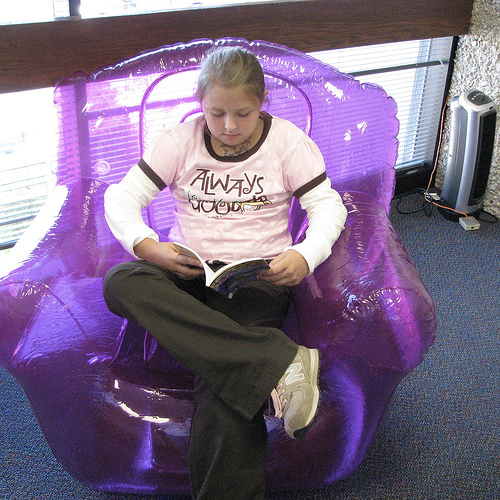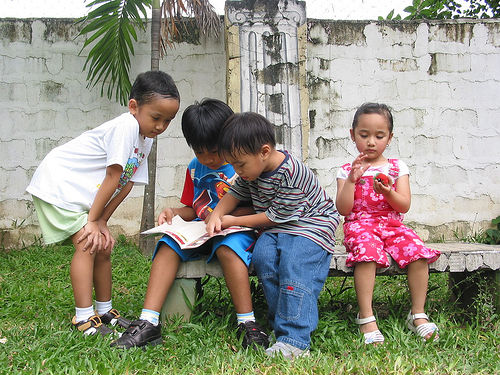I just downloaded the Renaissance Learning’s (the Accelerated Reader folks) report, What Kids Are Reading: The Book-Reading Habits of Students in American Schools. Because kids take AR tests after reading a book, they have an incredible database of more than 7.6 million students from 24,265 schools who read more than 241 million books during the 2012-2011 school year.
This is a fascinating report. It is actual figures from kids who read a book and took a test on it. Notice that in order to be included in this report, a student must have attended a school which uses the AR program AND taken a test on the book. Obviously, there are many students outside these parameters: not all schools use AR, students don’t always take tests on leisure reading. Still, this is a fascinating snapshot of reading habits of kids.
A note about AR tests: If your book doesn’t have an AR test, a teacher can write one. Here’s an example of what I’ve done for one of my books.
What are kids reading?
Grades 1-3
- Classics. Dr. Seuss’ Green Eggs and Ham and other titles dominate in first grade, second grade, and are strong in third grade, even though these books are a 1.5 reading level.
- Easy Read Series in Grades 1-3. Other easy read series are popular in the early grades, including titles about the dog, Biscuit, by Alyssa Satin. Tedd Ardold’s Fly Guy gets some reads, and Dav Pilkey’s Captain Underpants gets traction. Overall, the titles are classics, with few, if any contemporary books making the cut.
- Picture Books. Some picture books hit the lists in grades 1-3, but they are mostly classics like Laura Numeroff’s If You Give a Moose a Muffin, or David Shannon’s David Goes to School.
Grades 3-5
Diary of a Wimpy Kid reigns supreme from 3rd to 7th grade. Yes, it spans that large an audience. Otherwise–classics. Some early readers, picture books, some award winning books. Stone Fox by John Reynolds Gardiner; Charlotte’s Web by E.B. White; Alexander and the Terrible, Horrible, No Good, Very Bad Day by Judith Viorst; The Giving Tree by Shel Silverstein; Because of Winn Dixie by Kate DiCamillo; Sarah, Plain and Tall by Patricia MacLachlan. And of course, Captain Underpants and Dogzilla by Dav Pilkey.
Grades 6-8.
 Rick Riordan’s Lightning Thief series gains traction here, but it is quickly overtaken by classic novels required in literature classes. By 8th grade, the top book is The Outsiders by S.E. Hinton. Suzanne Collin’s Hunger Games series is battling Diary of a Wimpy Kid for top spots. The rest of it is pretty much a list of recommended literature studies units, with a few fun things thrown in like Harry Potter.
Rick Riordan’s Lightning Thief series gains traction here, but it is quickly overtaken by classic novels required in literature classes. By 8th grade, the top book is The Outsiders by S.E. Hinton. Suzanne Collin’s Hunger Games series is battling Diary of a Wimpy Kid for top spots. The rest of it is pretty much a list of recommended literature studies units, with a few fun things thrown in like Harry Potter.
Grades 9-12.
“In total, 388,963 ninth-twelfth graders read 2,290,522 books and 119,420,117,649 words during the 2010-11 school year. The average number of words read was 245,244 for boys and 345,725 for girls.”
Can we say literature class? Only a few contemporary titles like Hunger Games manages to make it into the top 40 on this list dominated by English teacher’s classic choices for literature units: Of Mice and Men, To Kill a Mockingbird, Night, Animal Farm, The Outsiders, The Great Gatsby, Lord of the Flies, The Giver and so on. Students do make some choices of reading material, it seems, but by and large the tested reading is dominated by literature classes.
Analysis of What Kids are Reading
We need more variety. We love the classics, really we do. But the range and quality of contemporary literature is amazing. Why are students stuck reading things written fifty years ago? We love Dr. Seuss for teaching kids to read, but what a sad thing to see almost no contemporary books on this list. Please, parents and educators–do whatever necessary to be more up to date in your reading habits, in pushing books toward beginning readers. Read Dr. Seuss, yes. But find three books or five books that have been published in the last five years that you love and introduce those to your students, too.
Literature Classes Dominate the Upper Grades. Why is reading dropping off and why do we have a literacy crisis in the U.S.? Could it be tied to the restrictive canon of literature required in English classes? The canon is mostly old, over 50 years old. Of course, we love the classics, they have endured and are, well, classic. But do they speak to the contemporary teen? Some will, but some won’t. Again, I appeal to you: with the range and quality of contemporary literature available, use some of these books in your classes!
Implications for Writers
You have a hard job: you must write the best story you can; you must find an editor who believes in the story; you must reach as many readers as possible. But know that in the schools, only a few books break through to the top. Of course, that’s true. To become the most popular of anything is hard to achieve: but it may even be harder for you because of the weight of the classics, which endure far past their time. With that heavy weight of stories behind you, it’s not enough to break through to the New York Times Best Seller’s list; to be read in schools, you must break into the English literature canon. Good luck. You’ll need it.

Very interesting. A lot of the obvious books are on the lists.
I would say the canon could be expanded.
Interesting about what kids are reading. I’m not surprised. My daughter read Dr. Seuss and many of the more recently published books on the list like Captain Underpants, Diary of a Wimpy Kid, the Percy Jackson series, and The Hunger Games.
I’m surprised there aren’t more recently published YA books on the list. Because my daughter’s language arts classes have promoted reading books for enjoyment for homework and she’s read a ton of them, especially dystopian novels.
Interesting topic. I think part of the reason contemporary books don’t make the list is that some schools don’t update their AR tests yearly, so kids have to read the books that are on the AR list. During the school year, my kids often choose books that they wouldn’t necessarily read if they weren’t reading for AR. That said, I still think it’s a great program to encourage reading.
What a helpful post! I found it quite informative. I just came from a reading (Friday) at a school that’s really into the A-R program. I think it’s a wonderful program, but I agree, the list of books could be expanded. Still, it’s a useful guide to what is being promoted. Thanks.
Suzanne:
It does come down to how the AR program is administered. Some schools update every two weeks, some only once a year. Part of that is money, part is time. But even at the schools which update often, classics still reign. It is just easier to stick with what you know, so teachers and librarians recommend those books because they know they work. The best educators rely on classics, but also keep up with trends and recommend contemporary literature. Hard to do!
Darcy